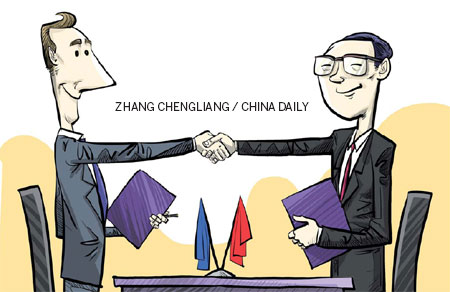

Investment agreement between China and EU can help smoothen the wrinkles in bilateral relations
Though trade and investment ties between China and the European Union have grown in recent times, they have also been marred by friction and disputes.
In the absence of other effective vehicles to improve policy exchanges between the two sides, an investment agreement seems to be the best option for the EU to gain more market access in China and reduce the simmering tensions between the two sides. China also stands to gain from such an investment agreement as it contains provisions for market access and protection for both sides.
Such an agreement will also help channel more Chinese investment into Europe and also protect Chinese investors from the arbitrary and discriminatory actions of individual European governments.
The proposed EU-China investment agreement will also be the first time that the European Union negotiates an investment-only agreement on the basis of the new powers granted by the Lisbon Treaty. The common investment tool will give the EU more power to protect its investments and negotiate market access with countries such as China.
However, some member nations do not share the EU's enthusiasm for centralizing investment policy in Europe. They are concerned that a common bilateral investment treaty with China would dilute the protection provisions granted to the member nations under their individual agreements.
This, however, seems to be a foregone conclusion. A critical part of the negotiations with China is the market access component and hence an attempt to establish symmetric market relations. What this means is that European and Chinese firms should have equal market access. The EU also wants to operate on the basis of equitable and reciprocal rules with China. Such a symmetry will happen only by improving access to China's markets and not, as some suggest, by decreasing Europe's openness.
With Chinese firms increasingly competing with EU firms in high-end sectors, the symmetry in market openness has become even more important. EU firms cannot fully participate in sectors such as transport, telecommunication, healthcare, distribution and business services in China.

The lack of reciprocity has also prompted the EU to resort to protectionist or confrontational approaches, as seen in the solar panel trade dispute with China, (and the potential case against Chinese telecom equipment). Even if full symmetry is not achieved, a good EU-China investment agreement that paves the way for more market access in China will help disarm those who want the EU to take a tough approach.
At the same time, there are also those who are worried that unlike the EU, China may not allow free market access. This is, however, not true as such an approach is not in China's economic interests.
China has proved several times in recent history that it can liberalize on an autonomous basis. Recent developments in Beijing suggest that new steps will be taken to free up markets for greater competition. It remains to be seen how far the Chinese leaders are willing to go, but an interesting sign came recently when China expressed its desire to be part of the Geneva talks for a new plurilateral agreement on trade in services, the so-called TISA.
China is the EU's second biggest trading partner, but only 2 percent of the EU's investment goes to China. Chinese investment accounts for only 1.5 percent of inward foreign direct investment in the EU.
The World Bank's (STRI) and the OECD's FDI restrictiveness indexes point to China's joint venture requirements, equity caps, administrative barriers, local content requirement and regulatory requirements such as technology disclosures, as particularly burdensome for investors. A conservative estimate by the European Commission suggests that elimination of these barriers can increase the EU's FDI stocks in China by 2 percent and boost the EU's annual exports to China by 2 billion euros.
The export figures also capture the largely intermediate inputs for the EU's affiliate sales in manufacturing (less so for services). Since 1978, China has modernized its agriculture and manufacturing sectors through liberalization.
Structural change is now needed again - especially economic reforms for China's transition toward a consumption-driven growth model. China also intends to develop its capacities in services, and R&D-based and high-end manufacturing sectors. Currently, these are sectors heavily dominated by state-owned and state-run enterprises. These sectors need reform if they are going to usher China toward a different growth model.
Furthermore, it is commonly acknowledged that reduction of investment barriers will increase productivity, employment and capital formation in sectors that are dominated by monopolistic players.
To attain its goals, China needs to further improve its services sector. Better access to foreign banking, transport, distribution, and telecommunication services will go a long way in boosting business performance.
Opening up to new investments also benefits China's outward interests. By 2020, China's FDI to the EU is set to grow ten-fold to around 250 to 500 billion euros. This will make China one of the major foreign investment stakeholders in Europe.
China also has an interest in ensuring that the markets in Europe will be open for Chinese investments and that they are not going to be subject to discrimination. Europe is not as open for foreign FDI as its prides itself on being. There are restrictions in several sectors and the more a sector is dependent on political decisions, or influenced by state-owned enterprises, the greater the FDI restrictions.
Since China has a record of making investments in such sectors (energy, infrastructure, public utilities, airport management, telecommunications, etc.), the greater its interest should be to secure market access and protection from discrimination.
Most of the bilateral investment agreements that China has with the EU nations are also not of top standard. Provisions in these agreements vary, while its vagueness makes it susceptible to multiple interpretations.
Both sides need to ink agreements with better legal clarity and precision, ones that are binding and not just rehearsals of ambiguous and broad legal concepts. The latter often leads to confusion and unpredictability and prompts firms to test the limits of an agreement through investor-state litigation, adding to more tension.
Inevitably, Chinese businesses will expand and increasingly operate in the EU. A uniform set of regulations will drive down costs to manage these investments, and investment conditions will become more predictable.
Investment agreements are typically signed to protect investments. Adding a market access component is a new undertaking, but it is an important one to establish market symmetry. EU-China commercial relations have often been fraught by disputes and tensions - and there has to be constructive and cooperative ways for the two to defuse tensions and improve the policy conditions for further integration.
A free trade agreement between the EU and China is currently not on the cards. The talks around updating the Partnership and Cooperation Agreement have lost traction. The High-level Trade and Economic Dialogue has failed to establish a good platform for business-like negotiations to resolve problems.
Negotiations over a new investment agreement can give purpose and direction to bilateral policy cooperation. Leaders from both sides would be wise enough to use this opportunity for better ties.
The author is a research associate at the Brussels-based European Centre for International Political Economy, an independent and non-profit policy research think tank. The views do not necessarily reflect those of China Daily.

( China Daily European Weekly 11/15/2013 page12)









